Chapter 6 - Ethical Culture Fieldston School
Chapter 6 - Ethical Culture Fieldston School
Chapter 6 - Ethical Culture Fieldston School
You also want an ePaper? Increase the reach of your titles
YUMPU automatically turns print PDFs into web optimized ePapers that Google loves.
“Mr. Sinatra Gets Rejected”<br />
outlook. But I suspect that the series of thoughts and experiences that led him to<br />
wield a sledgehammer that March day originated in a relatively unprepossessing<br />
house in Hoboken. The real ground‐breaking took place there.<br />
“He didn’t dream. He said, ‘I’m gonna do it. I’m gonna get across this river.<br />
I’m gonna go there [New York City] and make a name for myself.’”<br />
‐‐Tina Sinatra on her father’s youth in Hoboken 10<br />
“As I left the theater, with the shriek of young lungs still ringing in my ears, I was bothered by a<br />
strange discovery – that you could become a public idol simply by looking young, sad, and<br />
undernourished, then by skimming off a certain amount of your misery and pouring it into a<br />
microphone.”<br />
‐‐journalist Jack Long after a Sinatra performance, 1943 11<br />
It may be a perverse tribute to the elasticity of the American Dream that<br />
by the early twentieth century Martin Sinatra would adopt an Irish name –<br />
O’Brien – as a means of upward mobility. Of course, he probably didn’t think<br />
about his situation exactly this way. For the young Sicilian immigrant, it was<br />
probably more a matter of common sense: there was no way an aspiring boxer<br />
was ever going to get into a gym, nevermind a ring, with a name like Sinatra.<br />
Perhaps he was aware that there was a time when people with names like<br />
“Kennedy” had been viewed with the same degree of disdain and dismay that<br />
the Italians like him were. Perhaps he could anticipate a time when there would<br />
be those (Puerto Ricans? Koreans?) who would take their place at the bottom of<br />
the pecking order along with a fixed underclass of Negroes. But he probably<br />
didn’t spend a lot of time thinking about it.<br />
9 As noted elsewhere, Sinatra held a fund-raiser for Martin Luther King in the early sixties; his ties to<br />
Monaco stem from his friendship with (future princess) Grace Kelly, which took root during their work<br />
together in the 1956 film High Society.<br />
10 John Lahr, Sinatra: The Artist and the Man (New York: Random House, 1997), p. 4.<br />
11 Jack Long, “Sweet Dreams and Dynamite,” The American, September 1943 (included in Legend: Frank<br />
Sinatra and the American Dream, edited by Ethlie Ann Vare (New York: Boulevard Books, 1995), p. 9.<br />
American History for Cynical Beginners<br />
6
















